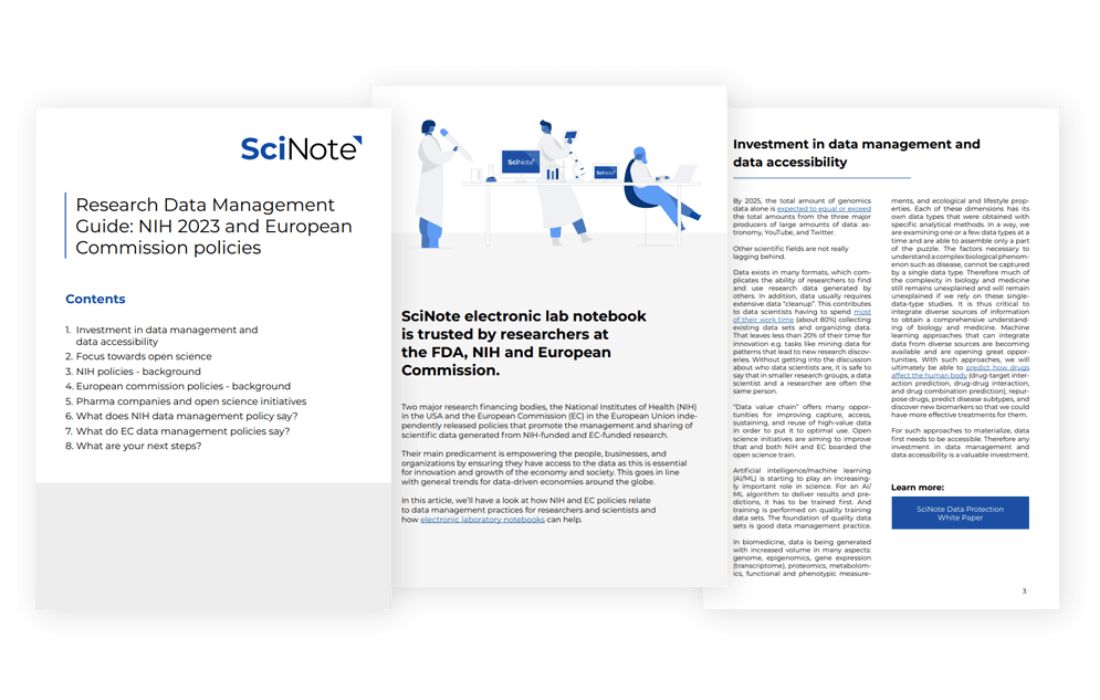NIH Data Management and Sharing Policy – 9 tips for preparing your DMS plan [Guide]
![]() 11 min read
11 min read
On January 25, 2023, the new NIH data management and sharing policy issued by the National Institutes of Health (NIH) in the US will take effect. This means all funding applicants with projects that will generate scientific data will need to prepare 2-page data management and sharing (DMS) plans as part of their application packages. This blog post will highlight the key expectations in the policy and offer tips on how applicants can prepare their data management plan.
This blog post is part of the Data Management and Sharing series. See also:
Contents
Key expectations of the NIH Data Management and Sharing Policy
“With this new policy, we aim to shift the culture of research to make data sharing commonplace and unexceptional.” – Francis S. Collins, M.D., Ph.D. Director, National Institutes of Health
The new policy was first issued on October 29, 2020; since then, additional details and resources have been made available. From a practical perspective, there are three key expected steps as outlined by NIH:
- Plan and budget for the managing and sharing of data
- Submit a DMS plan for review when applying for funding
- Implement/Comply with the approved DMS plan
Much like thinking about how you will collect and analyze data before you start your experiment, it makes sense to start thinking about data sharing and management as you plan for your project. Providing a complete and acceptable DMS plan is a requirement for receiving NIH research funding; failure to do so could significantly impact the progress of your project.
This blog post will focus on the planning and budgeting step, with specific references to NIH policy and resources. It is worth keeping in mind the spirit of this policy – to maximize the availability of scientific data. Data management should align with the FAIR data principles to make data findable, accessible, interoperable, and reusable. However, it does not necessitate all data to be shared (more on this later). Another thing to note is the emphasis on prospective planning; NIH expects that you have a full understanding of how your scientific data will be managed and shared.
Before we go further, do keep in mind that the goal of this blog post is to provide a helpful guide, and all resources cited within this blog post should be reliable. However, this is not an official NIH documentation in any way, shape, or form, and does not serve as the official guide for the NIH DMS policy. Make sure to refer to the NIH website for its policy and guidelines. If you have any questions, contact the NIH program officers or your institutional support for more information. Lastly, NIH provides many useful resources for applicants to help them with the transition; visit the NIH website for more information.
See how data management policies could affect you
Get your white paper on the NIH 2023 and European Commission policies for free:
Tip 1: check whether your research is subjected to the NIH Data Management and Sharing Policy
Ongoing awards: Based on the NIH webinar on the DMS policy, projects with ongoing awards won’t be asked to retroactively satisfy this policy; it is only when they are entering into a competitive renewal that DMS plans will be required.
Applicable research activities: The policy is applicable to research that generate scientific data (Research Projects, Some Career Development Awards (Ks), Small Business SBIR/STTR, and Research Centers), not to research or activities that do not generate scientific data (e.g., training, fellowship, and a few other activities). NIH provides a complete list of activity codes that are subjected to the DMS policy, so you can check to see if the policy is applicable to your funding request.
Additional considerations: Other NIH Institutes and Centers might have additional policies regarding data sharing. Review those policies to see if they apply to your project. You can also use NIH’s decision tool to help you determine which policies apply to your research.
Tip 2: understand the definition of “scientific data” & other factors limiting data sharing
NIH defines scientific data as:
“The recorded factual material commonly accepted in the scientific community as of sufficient quality to validate and replicate research findings, regardless of whether the data are used to support scholarly publications. Scientific data do not include laboratory notebooks, preliminary analyses, completed case report forms, drafts of scientific papers, plans for future research, peer reviews, communications with colleagues, or physical objects, such as laboratory specimens.”
So, no, NIH does not expect sharing all your lab notebooks and preliminary analyses as part of your DMS plan. However, what constitutes as “data” could largely depend on your usage and context; it is important to define this and relevant standards in your DMS plan. If you are in any doubt, consult your NIH program officer or institutional support.
There could be ethical, legal, and technical factors limiting the sharing of your scientific data. Examples given by NIH in their webinar include:
- Lack of or limited informed consent
- Privacy/safety or participants
- Federal/state/local/tribal laws and regulations
- Restrictions due to existing/anticipated agreements with other parties (e.g. proprietary data).
NIH’s video “Diving Deeper into the New NIH Data Management and Sharing (DMS) Policy” provides an in-depth discussion into these limitations. If other factors could limit your data sharing, make sure to watch the video, and contact NIH for additional assistance. Factors such as these should be disclosed within your DMS plan.
Keep in mind that NIH does not consider the following as justifiable reasons for not sharing your data:
- You have a small data set
- You anticipate your data won’t be widely used
- You don’t think there is a suitable repository for the data
Tip 3: use the plan format provided by NIH
NIH provides a DMS plan format (Word doc) that you can use to prepare your DMS plan. While NIH doesn’t require applicants to use this particular format, it is expected that the majority of the applicants will. Sticking with the format will ensure that you don’t miss any information required by NIH, and will make it easier for NIH staff to review your plan.
The italics text within the format can be deleted to make room for your DMS plan content.
If your institution is a participant of the DMPTool – a free, open-source, online application that helps researchers create data management plans, you can build your NIH DMS directly in the DMPTool. It should have the NIH DMS plan format already loaded within the tool so that you can simply fill out your plan accordingly.
Tip 4: Address 6 key elements in your plan and review NIH samples
Here are the 6 elements your DMS plan should consist of:
- Data Type
- Related Tools, Software and/or Code
- Standards
- Data Preservation, Access, and Associated Timelines
- Access, Distribution, or Reuse Considerations
- Oversight of Data Management and Sharing
As mentioned, you shouldn’t miss anything if you’re following the NIH plan format directly.
NIH spells out these 6 key elements in details – This is the most important information to go through in preparing your DMA plan. Make sure to include all the information NIH asks for, and answers the questions NIH asks. Here, a summary of what to include in these 6 elements is provided by NIH in a webinar. In cases where your data sharing will be limited by factors described earlier, make sure to provide justification for such exclusions.
NIH also provided a few samples on its website, so you can see what a completed plan should look like. Your institution might be able to provide additional samples prepared to guide researchers. For example, the University of Michigan ORSP (Research) and Sponsored Programs (Finance) offices went through an example in their recent webinar video.
Tip 5: identify the repository you will share to
Keep in mind that not having a suitable repository to submit to is not a justifiable reason for not sharing your data. Therefore, it is your responsible to ensure that you identify an appropriate repository to submit to, and to include the information within your DMS plan.
NIH has made this relatively easy – you can find all the possible options through NIH’s Repositories for Sharing Scientific Data tool.
In some cases, NIH will have instructions on which repository should be used for specific programs and data types. Outside of that, you would select a repository that is appropriate for your data type and discipline, and indicate so within your DMS plan. If no appropriate repository is immediately clear to you, NIH provides a list of resources where you can find a repository to submit to, and a list of criteria that NIH considers desirable. Lastly, some institutions offer repository services, so it is worth checking with your institutional librarian.
Again, keep in mind that the goal of the DMS policy is to maximize data sharing – so sharing your data through a repository will facilitate this.
The Network of the National Library of Medicine [NNLM] provides a short overview about selecting a repository in their video about the NIH DMS policy.
Tip 6: consider DMS implementation costs in your budget
While the DMS plan is reviewed only by NIH staff, the budget itself will be reviewed by the reviewers. NIH has indicated that a few types of expenses associated with the DMS plan are allowable:
- Curating data and developing supporting documentation
- Local data management considerations
- Preserving and sharing data through established repositories
NIH has also clarified that NIH won’t cover the following costs:
- Institutional overhead
- Routine costs associated with conducting the research
- Costs that are double charged or inconsistently charged regarding direct and indirect costs
It is important to note that you must cover the cost within your performance period, even if your preservation and sharing will extend beyond your performance period. For example, if you propose to make the data preserved and available for 20 years, all associated costs must be paid for before the end of your performance period.
Within your budget, indicate a line item to on the cost of your DMS plan. You can then include a short summary of the DMS plan and outline associated costs within your budget justification.
Data management and sharing:
See which way of recording research data will make data management and sharing easier.
Tip 7: understand the review process and compliance requirements
As mentioned, your DMS plan will be reviewed by NIH staff to determine if your DMS is appropriate. If your DMS plan isn’t deemed reasonable by NIH, NIH staff will reach out to work with you to revise your DMS plan. It is important to note that applications selected for funding will only be funded when the NIH staff consider the DMS plan complete and acceptable.
Once approved by NIH, you will be measured against your own plan (again, the emphasis is on prospective planning) when it comes to compliance. Your progress will be monitored by NIH through the annual PRRP reporting process; NIH staff will reach out if there are challenges, or if the plan needs to be updated. You might also identify additional individuals within your DMS plan who will oversee the implementation of your plan.
When it comes to when data should be shared, NIH states that
In NIH’s webinar, it further specifies that “associated publication” is referring to the publication of findings in a peer-reviewed journal, and that “end of performance period” is the end of the award. It is worth noting that pre-prints are not considered peer-reviewed publications. There might also be other policies you will need to consider, such as those set out by publishers or repositories.
Tip 8: go through the NIH resources – starting with this YouTube video
NIH has provided plenty of resources to support researchers in preparing the DMS plan. While it can seem overwhelming, it is worth reviewing the NIH resources to make sure you address all key elements NIH requests so to avoid funding delays in the future.
A good place to start is with NIH’s YouTube video Understanding the New NIH Data Management and Sharing (DMS) Policy, which provides an excellent overview of the policy; much of the blog post is based on the presentation and the Q&A of the video. From there, you can go on to visit NIH’s Data Management and Sharing Policy resource, where you can find what you need to know about the policy and the preparation of your DMS plan. Finally, if you have data that might meet the exclusion criteria, make sure to watch the other NIH YouTube video “Diving Deeper into the New NIH Data Management and Sharing (DMS) Policy” for more information.
At the end of the day, data management and sharing should be part of a good research project plan. Having a good DMS plan will not only help prevent delays in receiving your research funding, but will help you make sure your data will have the greatest impact in the future.

If you like this post also check out:
- Data management and sharing: Paper vs OneNote vs SciNote [comparison]
- Implementing SciNote Electronic Lab Notebook in an academic lab
- Using Data Lineage and Traceability to Optimize Publishing Potential
- NIH issues a seismic mandate: share data publicly by Nature
- The New NIH Data Sharing Policy 2023 – Why Sharing is Caring
Are you ready to implement your data management plan?
Talk to our team & get the top-rated customer service in the ELN industry.






